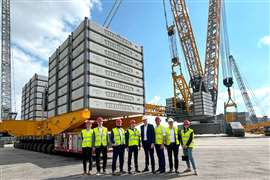Heavy lifts with the latest below the hook equipment
14 August 2023
New and custom below the hook equipment allows operators to move complicated and heavy loads to where they need to be. Niamh Marriott reports
Legislation and design standards play a very important role in the development of below the hook equipment, especially while considering the design factor of safety and satisfying the limit states of safety and serviceability, says UK-based lifting equipment and specialist engineering company Modulift.
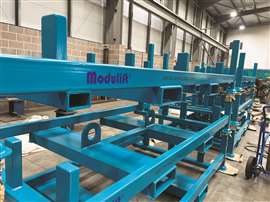 Modulift developed custom logistic and storage cradles using 3D structural design software. (Photo: Modulift)
Modulift developed custom logistic and storage cradles using 3D structural design software. (Photo: Modulift)
Handling requirements are also a driving factor for BTH equipment design, says Modulift. The company uses technology such as 3D structural analysis and finite element analysis to develop the most optimum design solutions which would satisfy design standards without compromising safety.
The company continues to innovate for the lifting industry and has launched its new multi-point beam as well as recently updating its CMOD modular spreader frame design.
The new multi-point beam is designed to save rigging time and maximise use across multiple lifting applications as it can be used as a semi-spreader or a lifting beam, and it is ideal for tandem lift operations. Operators can lift across multiple points at varied spans as multiple connection points on the top and bottom provide flexibility.
With detachable components, the beam lifts at spans from 3 to 12 metres, with a lifting capacity from 12 tonnes all the way up to 600 tonnes.
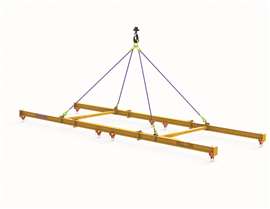 Modulift used 3D connection design software Idea Statica to perform FEA and stress checks on a customised lifting frame. (Photo: Modulift)
Modulift used 3D connection design software Idea Statica to perform FEA and stress checks on a customised lifting frame. (Photo: Modulift)
 Modulift’s new Multi-Point beam. (Photo: Modulift)
Modulift’s new Multi-Point beam. (Photo: Modulift)
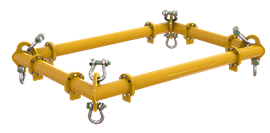 Modulift’s updated CMOD spreader frame with shackles. (Photo: Modulift)
Modulift’s updated CMOD spreader frame with shackles. (Photo: Modulift)
The CMOD spreader frame has been updated with a more lightweight corner unit design. The development arose from a meticulous design process using ANSYS software. Modulift’s team of in-house engineers conducted a non-linear contact stress analysis on the corner unit bow, simulating a full design load applied through the shackle. As a result, the new and improved corner units minimize contact stresses between the top shackle bow and corner unit centre plate, providing optimal performance and durability.
Custom design
As well as manufacturing its own products and completing in-house testing, Modulift also develops many customised solutions too.
It recently worked on creating custom logistic and storage cradles using 3D structural design software STAAD Pro, 3D modelling and drawing software Solidworks. The cradles were designed and manufactured to store the end units, drop links, struts, and shackles of the MOD 110H and MOD 250. Each cradle is lightweight and has 3 layers. The MOD 110H cradle weighs 3.3 tonnes when loaded, and the MOD 250 cradle 4.2 tonnes. The cradles have a special connection plate for the shackles to be connected. Each layer of the cradle is equipped with forklift pockets for easy lifting and transport. The cradles have accurately positioned uprights for securely placing the spreader beam end units, drop links, and struts.
Modulift also developed a custom H-frame for low height or tandem lifting applications. The main beam has multiple lifting points every 500 mm, offering a wide ranging lifting span. It can be used as a standalone lifting beam without any cross beams attached. This is designed to make it easier to adjust and move if required. The H-Frame cross beams can be adjusted in both longitudinal and transverse directions and all the bottom Pewag PLZW lifting points are removable. The frame has two Pewag AWHW 10 weld-on hooks at each end. Removable pins connect the cross beam, main beam and top lugs, making adjustment safe and convenient.
Modulift used 3D connection design software Idea Statica to perform FEA and stress checks on the connection plates of a customised lifting frame. One of the critical areas of design was the flange connection on the main beam. The analysis highlighted critical stress zones and confirmed that the flange connection was safe and complies with current design standards.
“It is important to develop multi-functional BTH equipment,” says a Modulift spokesperson. “Customers always expect BTH equipment to be adjustable to suit various lifting spans, to be suitable for variable headroom conditions, be lightweight and modular for ease of handling, quick to assemble and have maximum compatibility with the various brands of shackles and various types of slings.”
“Modulift always makes an effort to fulfil the above requirements and respect industry trends and customer demands while designing any BTH equipment whether it is custom or a standard product.”
 Modulift’s analysis of stress checks on the connection plates of a customised lifting frame. (Photo: Modulift)
Modulift’s analysis of stress checks on the connection plates of a customised lifting frame. (Photo: Modulift)
FIRE TRUCK LIFT
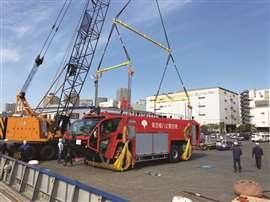
Japanese-based lifting gear company Nakamura Industry and its customer lifted a 21 tonne fire truck using Modulift spreader beams from a port in Tokyo to a nearby island.
Below-the-hook, Nakamura’s customer employed three Modulift spreader beams; one MOD 34 at a span of 6.5 metres attached using wire rope slings to the crane hook, and two MOD 24 spreader beams rigged underneath at 3.5 metres. The spreader beams formed a one-over-two configuration, providing four lifting points over the wheels.
The bottom two spreader beams had chain block hoists attached to drop links at the end of each beam, capturing the centre of gravity. The hoists attached to specially designed webbing slings underneath the wheels, allowing it to be safely lifted on and off the vessel to be transported. The spreader beams were disassembled, and the same configuration used to unload the vehicle at its destination, where it will now serve the local airport.
American innovation
As a core crane market, the USA has a whole host of below the hook accessory manufacturers, and new products are being launched to market to aid operators in increasingly complex lifting work.
USA-based DICA offers its LiftGuard Sling Protectors which the company said can prevent damage to slings caused by contact with edges, corners, or protrusions from loads being lifted. They also keep the sling away from other significant contact points during lifting operations.
They offer four types of sling protector. Medium duty protectors are for use with synthetic slings. They can also be used with wire rope and chain slings. The heavy duty protectors offer enhanced durability and can be used with all synthetic, wire rope and chain slings. Its beam and plate design is specifically to be used with lifting steel I-beams and steel plate. Finally, there are coil units for lifting coils of steel, or similar objects.
Improving safety
Elsewhere in the USA, Engineered Rigging (ER) recently expanded its rental fleet with a series of 400 tonne and 1,343 tonne sling adjuster systems.
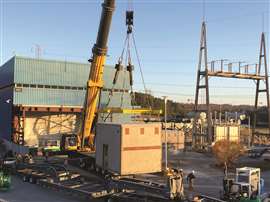 ER’s sling-adjuster system offers high precision positioning with horizontal and vertical loads. (Photo: Engineered Rigging)
ER’s sling-adjuster system offers high precision positioning with horizontal and vertical loads. (Photo: Engineered Rigging)
The synchronous hoist system operates below the hook as an innovative means to precisely position heavy and unbalanced loads in a vertical and horizontal plane.
The use of one crane, instead of two or more, improves safety, maximises operating speed and reduces costs, which makes the sling-adjuster an excellent option for onshore and offshore heavy lifting projects, the company says.
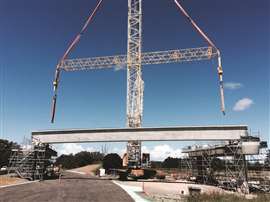 Engineered Rigging’s sling-adjuster rentals can be used for pre-programmed positioning, tilting and aligning. (Photo: Engineered Rigging)
Engineered Rigging’s sling-adjuster rentals can be used for pre-programmed positioning, tilting and aligning. (Photo: Engineered Rigging)
Engineered Rigging’s sling-adjuster rentals can be used for pre-programmed positioning, tilting, aligning and high precision horizontal and vertical load positioning. The specialized hydraulic cylinders are mounted in-line with the rigging which provides the operator with the ability to precisely monitor and adjust each lifting point independently from a remote location.
ER says this takes the guess work out of calculating the centre of gravity, expensive spreader beams, loading frames or estimating sling stretch per each leg of attachment.
Offshore operations
The sheer scale of operations in offshore work requires bigger components and accessories.
Dutch heavy duty crane and engineering specialist Huisman recently won a contract with Jan De Nul Group for the delivery of a 3,500 tonne monopile spreader bar.
This huge spreader bar will support and optimise installation of offshore wind turbines.
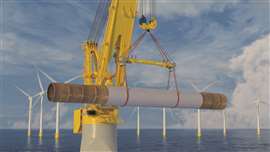 Huisman recently won a contract for the delivery of a 3,500 tonne monopile spreader bar. (Image: Huisman)
Huisman recently won a contract for the delivery of a 3,500 tonne monopile spreader bar. (Image: Huisman)
It can handle monopiles with the largest diameter and length currently available on the market and this is the third spreader bar order for Huisman.
Deployed in combination with the recently delivered 3,000 tonne Huisman leg encircling crane onboard the Voltaire and the 5,000 Huisman tub mounted crane onboard the Les Alizés, it will enable Jan De Nul Group to handle the largest monopiles in a safe and controlled manner.
Automated handling
Safe operations are ensured via automated sling handling of monopiles, reducing the number of personnel on deck.
The remotely controlled monopile spreader is powered by an on-board battery pack with integrated charger system for different external charging supplies.
As it seeks to support the development of renewable energy sectors, both on and offshore, Huisman is expanding its product and service portfolio.
The company designs, constructs and maintains a wide range of products to drive the growth of renewable energies and make mineral and fossil fuel extraction more sustainable.
Earlier this year, Huisman worked with Spanish wind energy specialist Siemens Gamesa to produce the Travelling Load Stabilising System (TLSS).
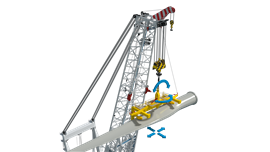 The Huisman and Siemens Gamesa TLSS can be used with all heavy cranes for wind turbine component installation. (Image: Huisman)
The Huisman and Siemens Gamesa TLSS can be used with all heavy cranes for wind turbine component installation. (Image: Huisman)
All components are affected but it especially applies to blades as they are designed to catch the wind. Controlling the movement of the relatively light components when suspended from a crane can now be done using the new system.
It helps reduce downtime and increase the integrity of the delicate wind turbine components, Huisman says. It can be used on any heavy lift cranes.
The system uses two pairs of tugger winches working together to control the position of the load. One pair is mounted on independent trolleys travelling along a rail on the crane boom. These trolleys follow the main hook block to maintain an optimal tugger line configuration.
The second pair operates from the tip of the crane giving a force perpendicular to the first pair of tuggers. This means by operating from different directions there is more control over the load than if using a conventional single pair of tuggers, Huisman says.
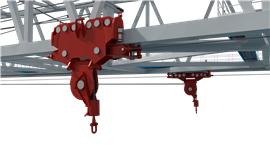 One of the two pairs of trolleys operated by tugger winches. (Image: Huisman)
One of the two pairs of trolleys operated by tugger winches. (Image: Huisman)
There is a control system to hold the position of the load to give “a stiffer restraint, and therefore a higher position accuracy compared to conventional tugger systems that rely on constant tension,” Huisman says. If there is an overload the system gives way but returns to its set position after that overload force dissipates.
As an integral part of the crane the TLSS can be operated from the operator’s cabin or via a portable wireless controller.
Joining forces
Commenting on the new system David Roodenburg, Huisman CEO, says, “The only way to accelerate the energy transition is through innovation enabled by the joint forces of industry partners. We have done this by combining the operational knowledge and experience of Siemens Gamesa with the technical equipment knowledge of Huisman. With the Travelling Load Stabilising System, we are very proud that together we can offer installation companies an efficient solution to reduce weather downtime, a challenging and delaying factor of wind turbine installation.”
For his part Jesper Moeller, Siemens Gamesa chief engineer execution, said, “This is crucial for the technical readiness of next-generation offshore wind turbine installations, even under challenging wind conditions. The resulting increase in installation uptime will be accompanied by a positive effect on the operational activities in general, as well as increased on-site safety.”
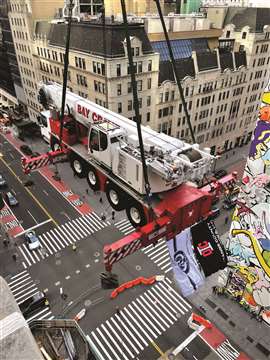 Working in New York City’s tight building space constraints, McLaren Engineering Group Orange County Ironworks lifted a Liebherr LTM 1130 wheeled mobile crane onto the roof of Tiffany & Co.’s flagship retail store using a 500 tonne capacity LTM 1500 to support the store’s renovation. DICA’s LiftGuard Sling Protectors were used to protect the slings during the lift. (Photo: Orange County Ironworks)
Working in New York City’s tight building space constraints, McLaren Engineering Group Orange County Ironworks lifted a Liebherr LTM 1130 wheeled mobile crane onto the roof of Tiffany & Co.’s flagship retail store using a 500 tonne capacity LTM 1500 to support the store’s renovation. DICA’s LiftGuard Sling Protectors were used to protect the slings during the lift. (Photo: Orange County Ironworks)
Doha glass installation
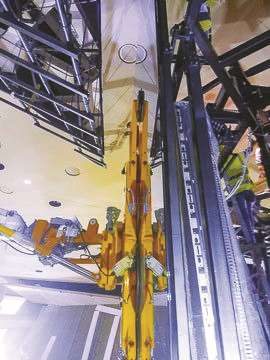
In the National Museum in Doha, Qatar, specialist contractor Heavydrive placed 38 panes weighing up to 850 kilogrammes. The confined space, the 5.2 metre high suspended ceiling and the delicate flooring in the gallery presented several challenges, including a lead time of just two weeks.
The Heavydrive team organised all the necessary freight and customs documents and arranged to transport the equipment, weighing 3,900 kilogrammes, by air.
For the complicated installation, Heavydrive supplied an MRK 144 S1 assembly crane with a lifting capacity of 2.9 tonnes and a lifting height of 14.9 metres, as well as a VSGU 1200 K vacuum suction system.
Featuring a 3-axle overhead manipulator, the suction system enabled the operator to rotate and lift the glass elements measuring 3.1 by 6.0 metres by radio remote control in the confined interior space. Thanks to the non-marking tracks and the emission-free electric drive, Heavydrive managed the installation inside the museum without a problem.
STAY CONNECTED


Receive the information you need when you need it through our world-leading magazines, newsletters and daily briefings.
CONNECT WITH THE TEAM












